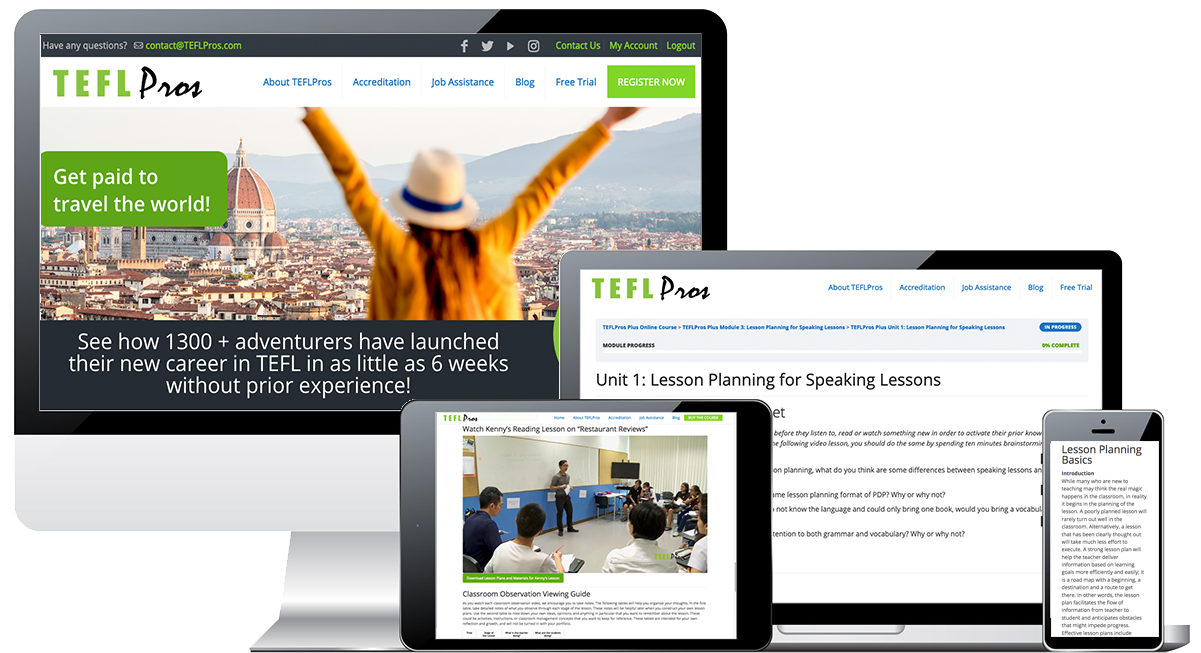
4 FREE Resources for Teaching Kids Online
March 2, 2021
How To Teach English Without A Degree
March 15, 2021
Our Step-by-Step Guide to Teaching EFL Using TED Talks

So, you’re ready to start teaching English to adults. Maybe you’re also wanting to branch out to teaching Business English. But where to begin? How can you easily create lessons your students will love? Whether you’re just starting out, or you’re a veteran TEFL Pro, read on for some great tips in our step-by-step guide to teaching EFL using TED Talks!
One of our favorite free resources is TED. TED is a nonprofit devoted to spreading great ideas. It has thousands of short, powerful talks which are perfect for teaching all the skills English learners need to know – from listening and speaking, to reading and writing. TED started back in 1984 as a conference to bring together folks from the diverse fields of Technology, Entertainment and Design. Now, it covers topics on science to business and everything in between — in more than 100 languages!
Today we’re going to share a listening lesson you can apply to any TED Talk. So without further ado – let’s jump in!
STEP #1 – RESEARCH
First, you’ll want to find out what topics interest your student. What’s their job? What industry are they in? Then, look on TED Talks to find a short video that would be a good fit.
For example, if your student is interested in Finance, you could share Wendy De La Rosa’s 10 Steps to Boost Your Financial Health- That You Can Do in a Day.
At this point you may be thinking “I can’t use a TED Talk. My student’s English fluency isn’t very high.” To this we would like to say “remember to grade the activity not the text”. In other words, you can adapt your activities to match with your student’s level of English and therefore still use real life videos that are relevant to their lives.
As with any lesson plan, you’ll want to be well prepared in advance. So before you introduce a video to your student, be sure to watch it a few times yourself first. You might even decide to skip some parts. (PRO TIP: You can find time stamps on the Transcript tab below the video. This can help you quickly navigate the video viewing portions of your lesson.)
STEP #2 – PREP SOME KEY VOCABULARY
From the talk, choose a few vocabulary words and phrases you think your student would find most useful. Think about words they could use in their work or daily life. Just pick out 3-5 words and 2-3 phrases. If you want, put the words on flashcards, find photos that illustrate their meaning, or think ahead about simple definitions and synonyms.
STEP #3 – START THE LESSON
Before you start the video, find out what your student already knows about the topic. Also, get them ready to start speaking in English! For example, for the topic of finance, you ask questions like, “Are you good at saving money?” or “What do you like to spend your money on?”
Also, now’s the time to take a few minutes to talk about those words and phrases you picked out earlier. Your student can practice pronouncing the words, and you can provide some simple definitions. (PRO TIP: It’s a really good idea to jot down the words in the chat box as well!)
STEP #4 – LISTEN TO CONFIRM PREDICTIONS
Before your student listens to the talk, give them a purpose for listening.
For example, have them predict what the video will be about (aka The Gist). Once they listen, discuss whether their predictions were correct or not. After confirming the main idea or gist, you can follow up with a question like, “Why do you think that?” to help the student practice their listening comprehension.
STEP #5 – LISTEN FOR GENERAL INFORMATION
Now, your student is ready to listen again, this time for some general information. Remember broad concepts are easier to grasp initially compared to specific details.
Ask them questions that require a simple Yes or No answer. You can also ask some broader, open-ended questions, with words that start with Who, What, Where, When, Why and How?
STEP #6 – LISTEN FOR DETAILS
Finally, your student is ready to listen once more, this time for details. Ask them questions that require a longer response or that test their listening comprehension on more specific details. For example, you can print out a part of the transcript, remove some of the words, and see if they can hear the missing words.
STEP #7 – GET THEM SPEAKING!
At this stage of the lesson, transition from listening to speaking. Using the tips on financial health video as an example, ask, “In your opinion, what was the most important tip?” and then, “Why do you say that?”
As a student is talking, don’t interrupt them to correct errors. Smile a lot! Encourage them to speak as much as possible! Be an active listener! You can make some notes in the chat box but wait to send them.
Also, this is a great time to check in to see if they were able to hear any of the words and phrases you shared earlier in the lesson.
STEP #8 – GIVE FEEDBACK
Once your student is finished talking, share a few vocabulary or grammar corrections. Don’t overwhelm them by pointing out every single error. Now is a good time to share your notes from the chat box. You might even give another example or two of how you would use the word or phrase in a sentence. Encourage your student to practice the corrected sentences on their own, after the lesson.
STEP #9 – ASSIGN HOMEWORK
To wrap up, assign “homework”. Give your student a little written project that they can do on their own. For example, keeping with the topic of financial health tips, ask your student to choose their favorite tip and explain why it’s their favorite. Then, have them send you their written response. You can correct it and send them your corrections.
Then, in your next class together, go over anything the student has questions about. (Don’t waste their time during class correcting their writing errors.)
Another homework idea is to have students print out the transcript of the talk (if possible). On their own, they can read through the transcript and highlight (or circle) the words and phrases learned earlier.
Finally, advanced students can do more research on the topic and prepare a presentation of their own!
We hope you’ve gained some great ideas from our step-by-step guide to teaching EFL using TED Talks!
And, as always, we wish you happy teaching!

